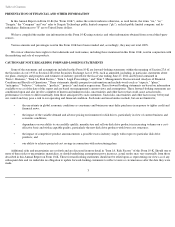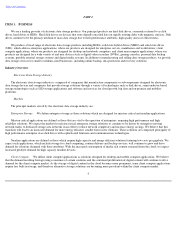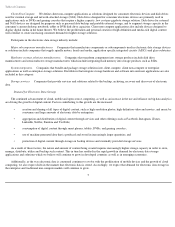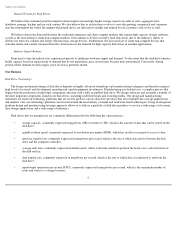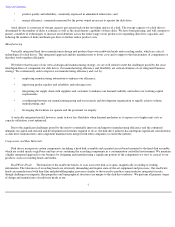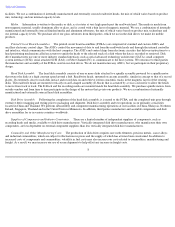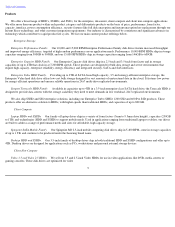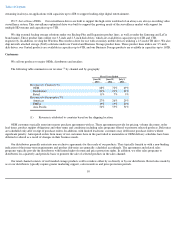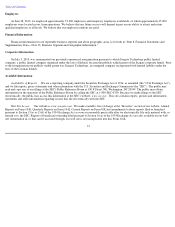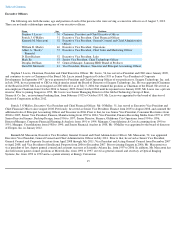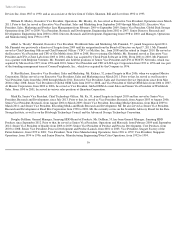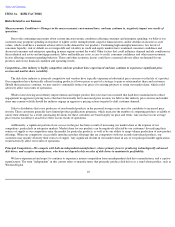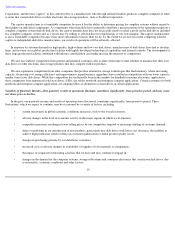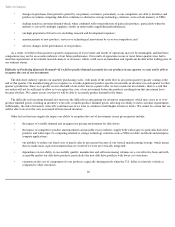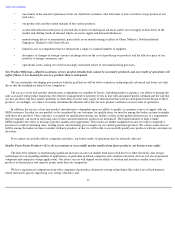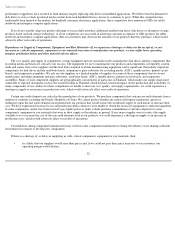Seagate 2012 Annual Report Download - page 16
Download and view the complete annual report
Please find page 16 of the 2012 Seagate annual report below. You can navigate through the pages in the report by either clicking on the pages listed below, or by using the keyword search tool below to find specific information within the annual report.
Table of Contents
unfavorably to us could have a material adverse effect on our business and results of operations. For more information on these claims, see
"Item 8. Financial Statements and Supplementary Data—Note 14, Legal, Environmental, and Other Contingencies." The costs of engaging in
intellectual property litigation in the past have been, and in the future may be, substantial, irrespective of the merits of the claim or the outcome.
We have patent licenses with a number of companies. Additionally, as part of our normal intellectual property practices, we may be engaged in
negotiations with other major electronic data storage companies and component manufacturers with respect to patent licenses.
Backlog
In view of industry practice, whereby customers may cancel or defer orders with little or no penalty, we believe backlog in the disk drive
industry is of limited indicative value in estimating future performance and results.
Environmental Matters
Our operations are subject to U.S. and foreign laws and regulations relating to the protection of the environment, including those governing
discharges of pollutants into the air and water, the management and disposal of hazardous substances and wastes and the cleanup of
contaminated sites. Some of our operations require environmental permits and controls to prevent and reduce air and water pollution, and these
permits are subject to modification, renewal and revocation by issuing authorities.
We have established environmental management systems and continually update environmental policies and standard operating procedures
for our operations worldwide. We believe that our operations are in material compliance with applicable environmental laws, regulations and
permits. We budget for operating and capital costs on an ongoing basis to comply with environmental laws. If additional or more stringent
requirements are imposed on us in the future, we could incur additional operating costs and capital expenditures.
Some environmental laws, such as the Comprehensive Environmental Response Compensation and Liability Act of 1980 (as amended, the
"Superfund" law) and its state equivalents, can impose liability for the cost of cleanup of contaminated sites upon any of the current or former
site owners or operators or upon parties who sent waste to these sites, regardless of whether the owner or operator owned the site at the time of
the release of hazardous substances or the lawfulness of the original disposal activity. We have been identified as a potentially responsible party
at several sites. At each of these sites, we have an assigned portion of the financial liability based on the type and amount of hazardous
substances disposed of by each party at the site and the number of financially viable parties. We have fulfilled our responsibilities at some of
these sites and remains involved in only a few at this time.
While our ultimate costs in connection with these sites is difficult to predict with complete accuracy, based our current estimates of cleanup
costs and its expected allocation of these costs, we do not expect costs in connection with these sites to be material.
We may be subject to various state, federal and international laws and regulations governing the environment, including those restricting the
presence of certain substances in electronic products. For example, the European Union ("EU") enacted the Restriction of the Use of Certain
Hazardous Substances in Electrical and Electronic Equipment, which prohibits the use of certain substances, including lead, in certain products,
including disk drives, put on the market after July 1, 2006. Similar legislation has been or may be enacted in other jurisdictions, including in the
United States, Canada, Mexico, Taiwan, China, Japan and others. The European Union REACH Directive (Registration, Evaluation,
Authorization, and Restriction of Chemicals, EC 1907/2006) also restricts substances of very high concern ("SVHCs") in products. If we or our
suppliers fail to comply with the substance restrictions, recycle requirements or other environmental requirements as they are enacted worldwide,
it could have a materially adverse effect on our business.
13


